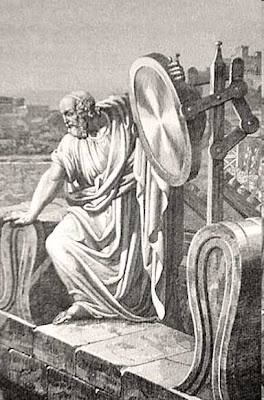.
Solar Energy
In the Beginning
In the Beginning

So where does the history of solar energy begin? It is my guess that it could have started when some caveman sat on a hot sun heated rock and burned his ass, perhaps later realising that this hot rock might have uses other than singeing his tush, perhaps he got to fry an egg on it?
Anyway we will never be able to know what our cavemen ancestors did with solar energy, so I may as well move on to the first big solar news story to get written up by the news media of the day.

Place; the city of Syracuse on the island of Sicily, Time; 214 to 212 BC. The Romans were besieging the city, which managed to hold out for three whole years! This feat was due, in no small part, to the sheer genius of the hero of this story, no other than the genius, the inventor, the philosopher; (can we have a big hand for) - Archimedes, the most famous citizen of that city.
 The cameras in those days were not too plentiful so Archimedes never got photographed
The cameras in those days were not too plentiful so Archimedes never got photographedI have included a nice image to remind us of the great man - taken from the Fields Medal
Most school kids have heard some talk of Archimedes and of his genius for mathematics and various inventions, particularly the Archimedes screw for lifting water.
During the siege of Syracuse, it is told that Archimedes came up with some of his most brilliant inventions in order to protect the city from the Roman ships. One of these was a crane like affair called the Archimedes “Claw” which was said to be able to grab and capsize a ship.

But arguable the greatest and certainly the most controversial invention which Archimedes is said to have constructed is a great mirror, or system of mirrors, capable of focusing the suns rays and thereby setting the Roman ships on fire.

Many historians and scientists seriously doubted the stories of Archimedes burning mirror. But in Athens in 1973, a Dr. loannis Sakkas, arranged for 70 flat bronze mirrors to focus the sun's rays on a plywood cut-out Roman galley at a distance of 165 feet. It only took some minutes for the plywood to burst into flame.
Other attempts to prove the legend have been carried out, several would seem to verify the possibility that Archimedes had indeed succeeded. A more recent attempt by the TV series "Myth Busters"concluded it was not a practical proposition.
Focusing the suns rays would become a major preoccupation with later solar energy scientists.
Tune in again soon for part two of this story.
.



No comments:
Post a Comment